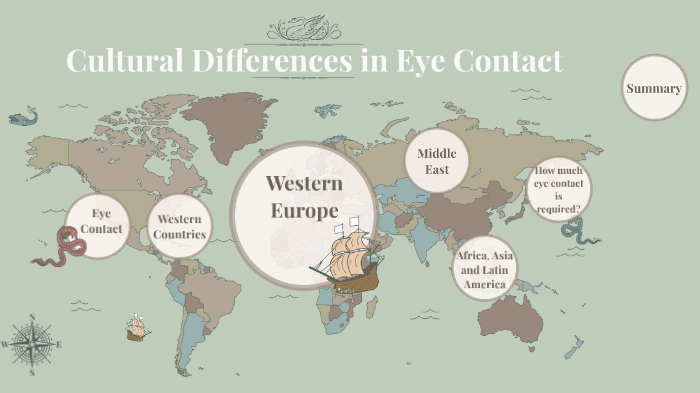Have you ever been in a conversation with someone and felt like you just couldn’t connect? Maybe their gaze was shifty, or they held your eye for too long, making you feel uncomfortable. This seemingly simple act of looking at another person can carry a world of meaning, and understanding its nuances across different cultures is essential for effective communication and building meaningful relationships.

Image: prezi.com
Eye contact is a powerful non-verbal cue that can convey a range of emotions, from interest and respect to dominance and aggression. We instinctively use it to gauge someone’s trustworthiness, their intentions, and even their emotional state. Yet, what’s considered appropriate and respectful in one culture can be seen as rude or even threatening in another. This article will delve into the fascinating world of eye contact in different cultures, exploring its complexities and offering insights into navigating this delicate aspect of human interaction.
Across the Globe, Different Glances
Eye contact is anything but universal. Across different continents and cultures, a simple glance can convey drastically different messages. Let’s dive into some of the fascinating variations:
The West: A Cultural Preference for Direct Eye Contact
In Western cultures, direct eye contact is generally seen as a sign of attentiveness, respect, and honesty. In business settings, it’s often expected during presentations and negotiations, as it signals confidence and sincerity. However, even within Western cultures, there are variations:
- The United States: Direct eye contact is generally encouraged. A prolonged gaze can even be interpreted as a sign of attraction.
- The United Kingdom: While direct eye contact is still valued, it’s considered polite to break eye contact occasionally to avoid seeming too intense.
- France: Prolonged eye contact can be considered challenging or aggressive.
The East: Shifting Sands of Eye Contact
Eastern cultures are known for their subtle non-verbal cues, and eye contact is no exception. Here, it’s often viewed as a sign of disrespect to look directly into someone’s eyes, particularly those who are older or have higher social status.
- Japan: Averting one’s gaze is considered respectful. Japanese people often look at the other person’s forehead or chin area instead of making direct eye contact. Holding someone’s gaze can be interpreted as aggression or confrontation.
- China: Similar to Japan, direct eye contact can be seen as rude or challenging, especially in formal settings. Maintaining a lower gaze, especially when talking to someone older or in a position of authority, is considered polite.
- India: Eye contact can vary based on social class, religion, and individual preference. However, it’s generally seen as less important than other forms of communication.

Image: alltalktraining.com
Beyond the West and East: A Global Mosaic
The diverse cultures of the world offer a rich tapestry of interpretations regarding eye contact. Here are some examples:
- Latin America: Direct eye contact is generally considered a sign of respect and interest, and prolonged eye contact can even be romantic.
- Arab Culture: Prolonged eye contact is considered a sign of respect, particularly among men. However, direct eye contact between a man and a woman can be seen as inappropriate.
- Africa: Eye contact can vary widely across different African cultures. Some tribes consider direct eye contact a sign of respect, while others avoid it entirely.
Navigating the World of Eye Contact: Tips for Sensitive Communication
Understanding the nuances of eye contact across different cultures is crucial for fostering meaningful relationships and avoiding misunderstandings. Here are some practical tips:
- Observe and adapt: Take the time to observe the behavior of those around you, especially when travelling to new cultures.
- Be mindful of social hierarchy: In cultures where eye contact is seen as a sign of disrespect, be mindful of social status and adjust your gaze accordingly.
- Don’t overthink it: Focus on being genuinely interested in the other person and their perspective. Your natural instinct will often guide you.
- Seek clarification: If you’re ever unsure about the appropriate level of eye contact, don’t hesitate to ask for clarification.
Eye Contact In Different Cultures
Building Bridges Through Understanding
In a world increasingly interconnected, understanding the cultural significance of eye contact is more important than ever. By respecting the unspoken language of different cultures, we can foster greater empathy, bridge cultural divides, and create deeper connections that transcend geographic boundaries.
Ultimately, eye contact is just one piece of the complex puzzle of communication. By embracing cultural differences and practicing empathy, we can navigate these nuanced expressions and build relationships that are both meaningful and respectful.






